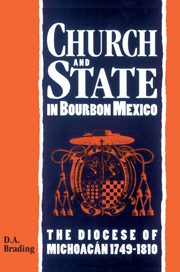11 - Tithes and chantries
Published online by Cambridge University Press: 01 February 2010
Summary
In 1501 the Holy See granted the king of Castile the income accruing from church tithes in the New World, a right which was confirmed in 1508 when the crown was recognised as universal patron of the American Church. From the start, however, the crown entrusted the management and receipt of this tax to the bishops and chapters of the Indies, merely reserving dos novenos (in fact a ninth) for royal expenditure, a sign of its primordial rights over this branch of revenue. In the first century of colonisation, even the dos novenos were often allocated for capital investment in church building. For their part, the Catholic hierarchy regarded the tithe as a universal Christian obligation, rooted in antiquity, supported by the Bible, and hence as an intrinsic right of the church. When the ministers of Charles III sought to encounter information about the tithe – its magnitude and its distribution – they soon found that circulars and rescripts to bishops in the Indies elicited remarkably little response. In 1774, therefore, the crown commanded that a royal accountant should be installed in all cathedral offices, whose function was to ensure that the royal ninth was fully collected. This accountant was paid from diocesan tithes and was subordinate to the jueces hacedores, the clerical judges who managed the collection and distribution of this tax. The rescript appointing these accountants openly complained ‘of the absolute and despotic management of this tax to the notorious harm of my royal exchequer, hospitals and cathedral fabric … taking into account that I enjoy the ownership and absolute dominion over these tithes, since they are the patrimonial goods of the Crown’.
- Type
- Chapter
- Information
- Church and State in Bourbon Mexico , pp. 211 - 227Publisher: Cambridge University PressPrint publication year: 1994

